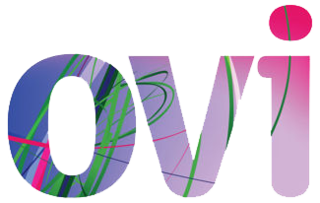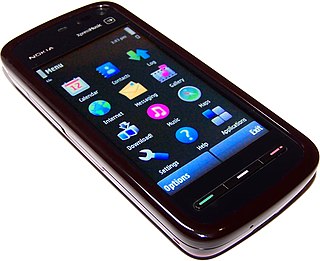
Adobe Flash is, except in China, a discontinued multimedia software platform used for production of animations, rich internet applications, desktop applications, mobile apps, mobile games, and embedded web browser video players.

The S60 Platform was a software platform for smartphones that runs on top of the Symbian operating system. It was created by Nokia based on the 'Pearl' user interface from Symbian Ltd. It was introduced at COMDEX in November 2001 and first shipped with the Nokia 7650 smartphone. The platform has since seen 5 updated editions. Series 60 was renamed to S60 in November 2005.

Binary Runtime Environment for Wireless was an application development platform created by Qualcomm, originally for code division multiple access (CDMA) mobile phones, featuring third-party applications such as mobile games. It was offered in some feature phones but not in smartphones. First developed in 1999, as a platform for wireless applications on CDMA-based mobile phones, it debuted in September 2001. As a software platform that can download and run small programs for playing games, sending messages, and sharing photos, the main advantage of Brew MP was that the application developers can easily port their applications among all Brew MP devices by providing a standardized set of application programming interfaces. Software for Brew MP enabled handsets can be developed in C or C++ using the freely downloadable Brew MP software development kit (SDK). The BREW runtime library is part of the wireless device on-chip firmware or operating system to allow programmers to develop applications without needing to code for system interface or understand wireless applications. BREW is described as a pseudo operating system, but not a true mobile operating system. BREW was not a virtual machine such as Java ME, but it runs a native code.
A Rich Internet Application is a web application that has many of the characteristics of desktop application software. The concept is closely related to a single-page application, and may allow the user interactive features such as drag and drop, background menu, WYSIWYG editing, etc. The concept was first introduced in 2002 by Macromedia to describe Macromedia Flash MX product. Throughout the 2000-s, the term was generalized to describe browser-based applications developed with other competing browser plugin technologies including Java applets, Microsoft Silverlight.
Adobe Flash Player is computer software for viewing multimedia content, executing rich Internet applications, and streaming audio and video content created on the Adobe Flash platform. It can run from a web browser as a browser plug-in or independently on supported devices. Originally created by FutureWave under the name FutureSplash Player, it was renamed to Macromedia Flash Player after Macromedia acquired FutureWave in 1996. It was then developed and distributed by Adobe Systems as Flash Player after Adobe acquired Macromedia in 2005. It is currently developed and distributed by Zhongcheng for users in China, and by Harman International for enterprise users outside of China, in collaboration with Adobe.
Series 40, often shortened as S40, is a software platform and application user interface (UI) software on Nokia's broad range of mid-tier feature phones, as well as on some of the Vertu line of luxury phones. It was one of the world's most widely used mobile phone platforms and found in hundreds of millions of devices. Nokia announced on 25 January 2012 that the company has sold over 1.5 billion Series 40 devices. It was not used for smartphones, with Nokia turning first to Symbian, then in 2012–2017 to Windows Phone, and most recently Android. However, in 2012 and 2013, several Series 40 phones from the Asha line, such as the 308, 309 and 311, were advertised as "smartphones" although they do not actually support smartphone features like multitasking or a fully fledged HTML browser.
Nokia Browser for Symbian was the default web browser for the S60 and Symbian mobile phone platform. The browser is based on a port of Apple Inc.'s open-source WebCore and JavaScriptCore frameworks which form the WebKit rendering engine that Apple uses in its Safari Web browser.

The Nokia N93 is a smartphone from Nokia, part of the multimedia Nseries. It was introduced on 25 April 2006 and released in July 2006. It runs on Symbian OS v9.1 and the S60 3rd Edition interface. It was the most advanced camera phone from Nokia at the time of its release, and was particularly marketed for its swivel design like its predecessor Nokia N90, which mimics the appearance of a conventional camcorder.

The Nokia N73 is a smartphone announced by Nokia on 2006 as part of the Nseries and started shipping on 15 July. The N73 succeeded the N70 and packed in numerous multimedia features. It features a 3.2 megapixel autofocus camera, a front camera, a then-large 2.4-inch display, and stereo speakers, all in a relatively slim and pocketable size and form. It runs on Symbian v9.1. An improved, music-focused version called N73 Music Edition was released in 2007.

Microsoft Silverlight is a discontinued application framework designed for writing and running rich internet applications, similar to Adobe's runtime, Adobe Flash. While early versions of Silverlight focused on streaming media, later versions supported multimedia, graphics, and animation, and gave support to developers for CLI languages and development tools. Silverlight was one of the two application development platforms for Windows Phone, but web pages using Silverlight did not run on the Windows Phone or Windows Mobile versions of Internet Explorer, as there was no Silverlight plugin for Internet Explorer on those platforms.
The Nokia 6000 series or Classic Business series is range of mobile phones marketed by Nokia. This family of phones is notable for their conservative, unisex designs, making them popular with business users.

Ovi by Nokia was the brand for Nokia's Internet services. The Ovi services could be used from a mobile device, computer or via the web. Nokia focused on five key service areas: Games, Maps, Media, Messaging and Music. Nokia's aim with Ovi was to include third party developers, such as operators and third-party services like Yahoo's Flickr photo site. With the announcement of Ovi Maps Player API, Nokia started to evolve their services into a platform, enabling third parties to make use of Nokia's Ovi services.
On-Device Portals (ODPs) allow mobile phone users to easily browse, purchase and use mobile content and services. An ODP platform enables operators to provide a consistent and branded on-device experience across their broadening portfolio of services and typically provides on-device catalogs of content for purchase, deep links to WAP portals, customer care functionality and rich media services such as full track music, TV and video.

Nokia 5800 XpressMusic is a smartphone part of the XpressMusic line, announced by Nokia on 2 October 2008 in London and started shipping in November of that year. Code-named "Tube", it was the first touchscreen-equipped S60 device by Nokia – essentially it was the first device to run Symbian^1, also known as S60 5th Edition, the touch-specific S60-based platform created by the Symbian Foundation. The touchscreen features tactile feedback.

The Nokia 5320 XpressMusic is a Symbian OS S60 smartphone, released by Nokia in 2008 as a part of their XpressMusic line of portable devices. The phone has a rugged candybar body with outlined keypads. It emphasizes music and multimedia playback. Among its highlights are a dedicated 3D audio chip for better sound quality, 24 hours of music playback, a 3.5 mm audio jack, N-Gage compatibility, and music/gaming keys. At the time of release the phone cost $220 in the U.S., European and Asian markets.

Origyn Web Browser (OWB) is a discontinued web browser that was synchronized with WebKit and sponsored by the technology company Pleyo. OWB provides a meta-port to an abstract platform with the aim of making porting to embedded or lightweight systems faster and easier. This port is used for embedded devices such as set-top boxes, and other consumer electronics.

Symbian is a discontinued mobile operating system (OS) and computing platform designed for smartphones. It was originally developed as a proprietary software OS for personal digital assistants in 1998 by the Symbian Ltd. consortium. Symbian OS is a descendant of Psion's EPOC, and was released exclusively on ARM processors, although an unreleased x86 port existed. Symbian was used by many major mobile phone brands, like Samsung, Motorola, Sony Ericsson, and above all by Nokia. It was also prevalent in Japan by brands including Fujitsu, Sharp and Mitsubishi. As a pioneer that established the smartphone industry, it was the most popular smartphone OS on a worldwide average until the end of 2010, at a time when smartphones were in limited use, when it was overtaken by iOS and Android. It was notably less popular in North America.

The Nokia N8 is a touchscreen-based smartphone developed by Nokia. Announced on 27 April 2010, the Nokia N8 was the first device to run on the Symbian^3 mobile operating system and it was the company's flagship device for the year. It was released on 30 September 2010 at the Nokia Online Store before being released in markets around the world on 1 October 2010. There were two version made, the N8 and the N8-00. The N8 was made for Vodafone and locked to its networks, and the N8-00 was made by Microsoft and open network.
Modern HTML5 has feature-parity with the now-obsolete Adobe Flash. Both include features for playing audio and video within web pages. Flash was specifically built to integrate vector graphics and light games in a web page, features that HTML5 also supports.











